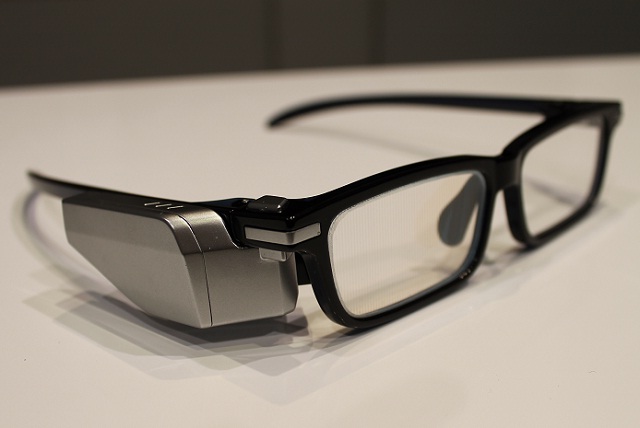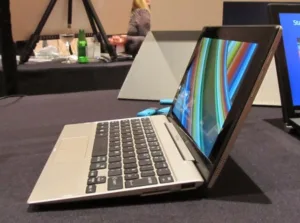Toshiba’s stand was largely full of conceptual devices, although there were only a few product announcements.
Security is more and more of a concern these days, so Toshiba has developed the Toshiba Zero Client Secured (TZCS) solution. It is a laptop-form factor zero client using a proprietary BIOS to increase security – although the ‘laptop’ is meant to remain in a very specific area. The TCZS server constantly monitors the client; if it is removed from the managed area, the client will be shut down and have its user data wiped.
Beacons are also growing in popularity, so Toshiba Semiconductor has a ‘push-and-pull’ beacon solution. Using Bluetooth and NFC, these beacons are used to transfer information from their attached signage displays to consumers’ mobile devices (through an opt-in, of course).
There was a demonstration of Toshiba Glass (Display Monitor Vol 21 No 40). This is the company’s augmented reality solution, aimed at the B2B market. Toshiba Glass uses a pico projector to provide an image, with reflectors in the right eyepiece to direct light into the wearer’s eye. We tried a demonstration of this device, but it was, honestly, not very impressive. The image quality was not great and well below the level of the Sony augmented reality glasses that we tried at IFA.
When Toshiba Glass was introduced at Ceatec, it was accused of being less sharp and dimmer than Google Glass (perhaps its most well-known competitor). The brightness issue, at least, appears to have been overcome at CES, according to some commentators, but we haven’t had a chance to try them close together.

Toshiba was also showing a virtual fitting room concept using a professional LCD display as a smart mirror, similar to the demonstrations at IFA last year.
Finally, the new products: Toshiba’s Satellite Click Mini and Encore 2 Write tablets. The Satellite Click Mini is – you guessed it – a smaller version of the Satellite Click convertible (Display Monitor Vol 21 No 4), featuring a detachable keyboard (with a touchpad). There is a battery in the tablet and a larger one in the keyboard, providing a total of 12 hours of battery life.
The 8.9″ display uses an IPS panel with 1920 x 1200 resolution and has 350cd/m² of brightness. There are two cameras (rear and front) and a year’s subscription to Office 365. The tablet runs Windows 8.1 on a 1.33GHz Intel Atom Z3735F processor. Storage is via a 32GB SSD, expandable using the micro-SD and full size SD slots on the tablet and keyboard (which also adds a full-size USB port to the micro-USB and mini-HDMI interfaces on the tablet). RAM is 2GB.
I was pleased to see a good travel distance on the keyboard’s keys – no first-generation Surface keyboard here – as well as the full-size USB connection; something of a rarity in the mobile space, and certainly useful for business travellers. Very few companies provide press releases on mini-USB sticks!
The Click Mini will be launched in late Q1 or early Q2 for €300, including the keyboard.
Like the Click Mini, the Encore 2 Write runs Windows 8.1 on the Z3735F processor. Available in 10.1″ (WT10PE-A) and 8″ (WT8PE-A), the tablet has 1280 x 800 resolution and is supplied with a Wacom stylus called the TruPen – supported by the pre-installed TruNote handwriting app.
These second-generation Encore Write tablets improve on last year’s model with pressure-sensitivity for the pen, enabling finer lines to be drawn. They also have palm-rejection and the same storage and RAM as the Click Mini. They are available now, for $400 (10.1″) and $350 (8″).
The Portege Z20T ultrabook was also being shown for its US launch (Display Monitor Vol 21 No 45).
A new addition to Toshiba’s Dynadock series was on show, the Dynadock 4K. It is able to connect to a source – such as a laptop – through USB, signals from which are then sent through the dock’s DisplayPort, HDMI or VGA ports. An internal graphics card enables the unit to support video resolutions up to UltraHD. Six USB 3.0 ports are also featured, for source devices and accessories such as mice and printers. The dock will go on sale in February, for $200.
Did I mention the horrifying android?
Chris had a good look at the autostereo 3D LCD that was on display – see Toshiba Shows Glasses-Free 3D Display at CES 2015
Display Daily Comment
There were no new TVs from Toshiba at the show – and this wasn’t simply a case of leaving them off the stand.
In a statement to Twice, Toshiba America said, ‘Toshiba Corporation is currently evaluating the business model for the U.S. consumer TV market as part of the company’s measures to reform its Visual Products business worldwide. Toshiba will announce the details when the decision has been finalised in the next few months’.
A source that we spoke to believes that Toshiba may change to a licensing model in the USA, as Sharp did in Europe last year (Display Monitor Vol 21 No 42). Compal said that it had agreed to buy Toshiba’s TV business in Europe. See this article for more (Toshiba is Re-Assessing its US TV Plans).

